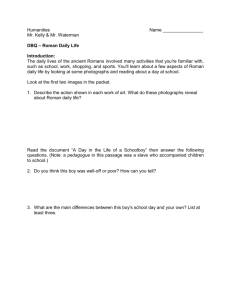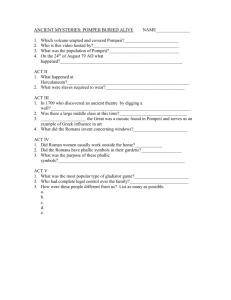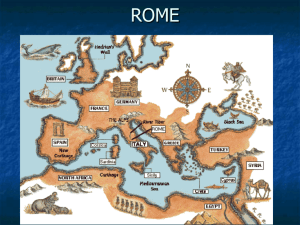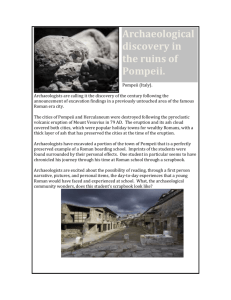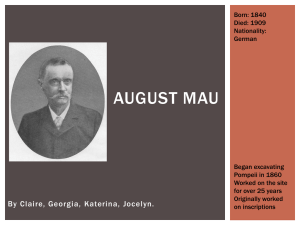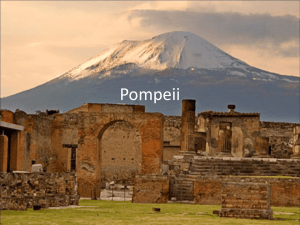Roman Art Part 2, Pompeii and Herculaneum
advertisement
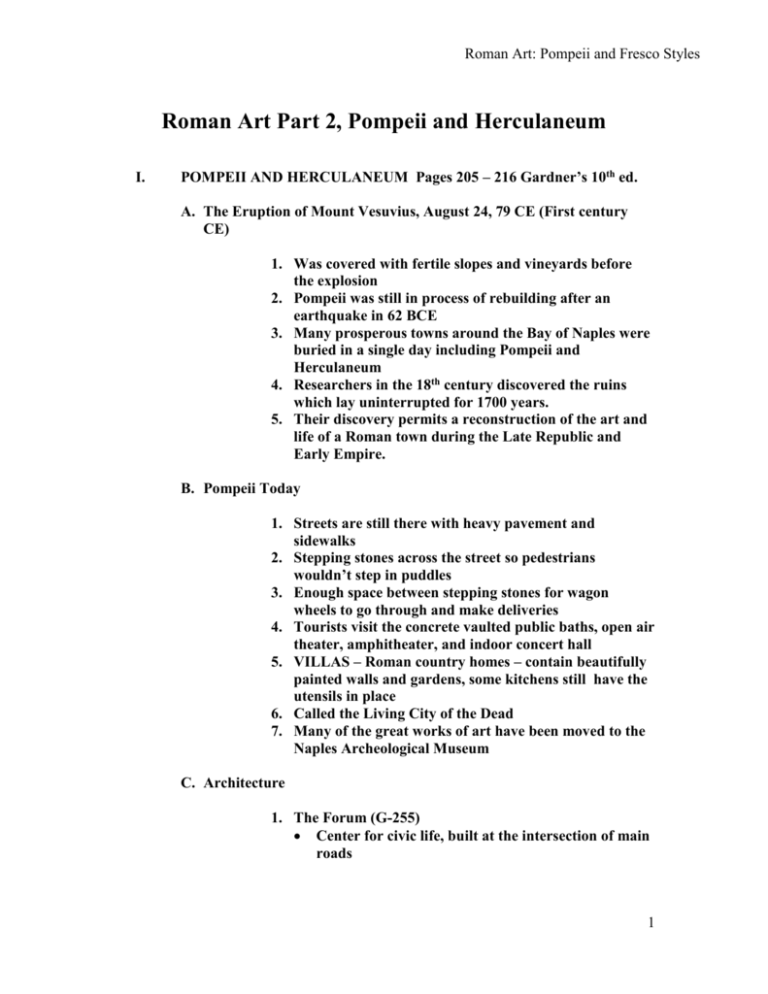
Roman Art: Pompeii and Fresco Styles Roman Art Part 2, Pompeii and Herculaneum I. POMPEII AND HERCULANEUM Pages 205 – 216 Gardner’s 10th ed. A. The Eruption of Mount Vesuvius, August 24, 79 CE (First century CE) 1. Was covered with fertile slopes and vineyards before the explosion 2. Pompeii was still in process of rebuilding after an earthquake in 62 BCE 3. Many prosperous towns around the Bay of Naples were buried in a single day including Pompeii and Herculaneum 4. Researchers in the 18th century discovered the ruins which lay uninterrupted for 1700 years. 5. Their discovery permits a reconstruction of the art and life of a Roman town during the Late Republic and Early Empire. B. Pompeii Today 1. Streets are still there with heavy pavement and sidewalks 2. Stepping stones across the street so pedestrians wouldn’t step in puddles 3. Enough space between stepping stones for wagon wheels to go through and make deliveries 4. Tourists visit the concrete vaulted public baths, open air theater, amphitheater, and indoor concert hall 5. VILLAS – Roman country homes – contain beautifully painted walls and gardens, some kitchens still have the utensils in place 6. Called the Living City of the Dead 7. Many of the great works of art have been moved to the Naples Archeological Museum C. Architecture 1. The Forum (G-255) Center for civic life, built at the intersection of main roads 1 Roman Art: Pompeii and Fresco Styles Open air structure only for pedestrian traffic, surrounded by colonnades (Corinthian columns). Shows the influence of Hellenistic design. Outside the open-air part, secular and religious structures A temple A BASILICA – a long narrow building used as courthouse and for government offices 2. An Amphitheater Earliest known amphitheater – 70 BCE Gladiator battles and wild animal hunts Arena (sandy floor) used for soaking up blood A fresco shows a brawl that broke out between Pompeian people and the neighboring Nucerians in 59 CE – many wounded and amphitheater was closed for a decade Notice the velarium (cloth awning) and double stair case (efficient entrance and exit) Major contrast functionally and architecturally with Greek theaters (G-151) STUDY CHART Location Appearance/type Pompeii, Italy Amphitheater (double Greek theater, giant oval Epidauros, Greece Theater (semicircular plan, open on one side Architectural materials/structure Concrete, barrel vaults Stone seats and steps support under the seating, barrel vault to enter arena Function Mass entertainment, spectacles Refined performances of comedies and tragedies Treatment of surrounding area Subjugation of nature, make an artificial mountain to create an amphitheater Work with nature, place the theater on the hillside 2 Roman Art: Pompeii and Fresco Styles 3. The Roman House (Domus) (G-256, 257) Fauces (throat of the house) – a narrow foyer opened to… Atrium – Central reception area, opening in roof (compluvium) to let light in and allowed rain water to collect Impluvium – basin below the opening in the roof to catch water, cisterns could be used to store the water for the household Cubicula – small bedrooms Triclinium – dining room Small kitchen and interior garden (peristyle garden) in back Evidence of similar homes found in Etruscan paintings Roman home was important. Romans entertained guests and wanted to look important. Roman homes had an internal focus. Plain on the outside, great attention to the interior, shut out the traffic and noise from the street Example: House of the Vettii (G-256) A must-see for tourists Vettii brothers owned the house Example: House of the Faun Shows the craze for all things Greek Named after Hellenistic-style bronze statue that stood in one of its two atriums Occupied an entire city-block! Two huge peristyle gardens! Mosaics decorate the floors of many of the rooms Alexander Mosaic (Battle of Issus) Battling Darius of Persia Copy of a Hellenistic panel painting D. Frescoes 1. Most complete record of changing fashions of interior decoration in the world 2. True frescoes – pigment was applied on wet plaster, a painstaking process, applied several layers of plaster with a trowel, if wealthy enough, mixed marble dust in with plaster 3. How many homes do you know that have custompainted murals in every room? 3 Roman Art: Pompeii and Fresco Styles E. Four styles of Pompeian Frescoes 1. First-Style Simulates costly marble panels Like using paneling in your home to simulate expensive wooden panels Hellenistic Greek precedent 2. Second-Style Creates the illusion of a three-dimensional world inside the room Example: Villa of the Mysteries at Pompeii (G-259) Use of Pompeian Red Used privately to celebrate the rites of Dionysus Mystery religion popular with women The rites were kept secret by the women Walls provide clues Women may have role played Ariadne, daughter of King Minos (Remember when Theseus ditched her on the island of Naxos?), uniting in marriage to Dionysus Illusion of a shallow ledge on which all the figures stand Figures from different walls interact with each other Woman with wings uses a whip that hits the back of a kneeling woman with a bare back on the right wall (part of an initiation?) Mature Second-Style – creates a three-dimensional world outside of the room (See example of reconstructed cubiculum M of House of P. Pannius at Metropolitan Museum of Art) Amazing sense of depth and perspective Transformed windowless rooms to “picture windows” Another example – Gardenscape from Villa of Livia (wife of Caesar Augustus) from Primaporta (north of Rome) Understanding of atmospheric perspective – gives a sense of depth – as objects recede into the distance, they appear fuzzier and less distinct, colors may appear bluish or purple in the distance All four walls had gardenscapes 4 Roman Art: Pompeii and Fresco Styles Fence, trees, and birds in foreground are precisely painted, details of foliage in background are indistinct 3. Third-Style – Delicate linear fantasies on monochromatic backgrounds Not trying to imitate marble panels, not trying to create illusion of three-dimenionality Notice very thin colonnettes, feather-weight canopy, tiny floating landscape in the center, all on a monochrome black background – Landscape is like a painting in a frame Does this look like a window into another world? Which landscape is better – Livia’s or this one? 4. Fourth-Style – Combines some elements of all the styles Example: Room for Nero’s Domus Aurea (Golden House) Sea creatures, birds, and other motifs on monochromatic backgrounds Views outside the room as well as some illusions Example – Frescoes on Triclinium P of House of Vettii Notice the elements of the other styles placed together in a crowded manner 5. Still – life with Peaches Important example of the Fourth-Style Found in Herculaneum Roman painters were interested in everyday objects as well as buildings and landscapes Artists paid close attention to shadows and highlights Worked directly from the arrangement Fruit, the stem and leaves, and glass jar set on different shelves – gives the illusion of the casual as if these objects were in a cupboard. Art historians have not found evidence of anything like these Roman studies of food and inanimate objects until Dutch still-life paintings of the 17th century!! Not exact in drawing, perspective, or rendering of light and shade like the Dutch Ancients still understood that the appearance of objects was a function of light – AMAZING! 5 Roman Art: Pompeii and Fresco Styles 6. Portrait of Husband and Wife fresco Shows diverse tastes of Roman frescoes Romans kept imagines (portrait busts) in homes, why not have painted portraits, too Man holds a scroll, woman holds a stylus and wax tablet – standard in Roman marriage portraits Indicates fine education – even if it wasn’t true and the individuals were uneducated and illiterate Roman equivalent of modern wedding portraits in which brides and grooms wear rented formal clothes that they will not wear again Heads are not of a standard type – Sensitive studies of the features of the man and woman F. Mosaics 1. Usually on floors in ancient times but Romans had mosaics on walls and ceilings, precursor of early Christian mosaic tradition. 6
